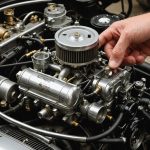Understanding Car Alignment
Car alignment is an essential aspect of DIY vehicle maintenance that directly impacts driving safety and vehicle performance. Ensuring that your car’s wheels are properly aligned means that they are angled correctly with each other and the road. This alignment not only improves fuel efficiency by reducing tyre wear, but also enhances the vehicle’s handling.
When car alignment is not properly attended to, several issues can arise. For instance, a misaligned vehicle may drift to one side while driving, requiring manual correction by the driver. This situation not only implies potential hazards but can also lead to uneven tyre wear, decreased fuel economy, and strain on various suspension components.
Additional reading : Ultimate Guide to Expert Care: Top Tips for Cleaning and Maintaining Your Convertible Soft Top in the UK
In the UK, automotive guidelines suggest regular checks and maintenance to ensure compliance with safety regulations. These checks play a pivotal role in assessing vehicle alignment and determining potential discrepancies that could compromise driving conditions. For UK drivers, adhering to such recommendations is not merely advisable—it’s a component of maintaining legal car standards, contributing to both road safety and efficiency.
For those interested in pursuing DIY vehicle maintenance, understanding the fundamentals of car alignment is paramount. This knowledge empowers car owners to assess alignment issues even prior to professional consultations, promoting a blend of proactive safety and cost-effective car care.
Additional reading : Ultimate Guide to Reviving Leather Seats in Classic UK Cars: Essential Restoration Steps
Tools Required for DIY Car Alignment
Undertaking a DIY car repair requires a good grasp of essential tools. For alignment tasks, an array of everyday tools can suffice, minimizing costs while ensuring efficiency.
Essential Tools Overview
Basic alignment checks can be performed with common tools. A tape measure, spirit level, and string are often sufficient for preliminary diagnoses. A jack is also necessary to lift the vehicle safely. Utilising these everyday tools reduces the need for expensive equipment while still achieving precise results.
Inexpensive Alternatives
For those on a budget, several cost-effective tools exist for alignment checks. Toe plates can measure the wheel’s angle, while camber gauges assess the tilt accurately. Checking for tire wear patterns or using an angle finder provides further insights. These alternatives are affordable and valuable additions to any DIY toolkit.
Tool Recommendations for UK Drivers
UK drivers should consider tools from local retailers, such as Halfords or Screwfix. These stores stock a range of equipment suited for car alignments. High-quality brands like Draper and Laser Tools offer durable products tailored to the UK market. By investing in these reliable brands, UK drivers can perform efficient and economical car repairs at home, ensuring optimal vehicle performance.
Step-by-Step Guide to Performing a Car Alignment Check
Performing a DIY car alignment check can save you time and money while ensuring your vehicle’s optimal performance. Here’s a concise step-by-step guide to help you complete a basic alignment check.
Initial Preparation
Start by parking your car on a flat surface. Ensure the tires are properly inflated and that your steering wheel is centred. These preliminary steps are crucial for accuracy in the alignment check.
Checking Wheel Alignment
Place a visible mark on the front of each front tire, at the center height. Using a measuring tape, measure the distance between these two marks. Keep this measurement in mind, as any deviation indicates misalignment. Repeat the process for the rear wheels. The measurements should match for both front and rear wheels to ensure alignment.
Evaluating Results
Compare the front and rear measurements. Consistency suggests proper alignment. If there’s a significant difference, it might indicate an issue with your car’s alignment needing professional assessment.
Visual Aids
Visual aids or diagrams can further enhance the understanding of this procedure. They provide a clear reference, making it easier for different car models and designs.
By following this step-by-step guide, you can maintain your vehicle’s performance and extend tire life. Regular checks through this DIY approach ensure safe and reliable driving experiences.
Troubleshooting Common Alignment Issues
Addressing common car problems involving alignment requires understanding and practical solutions. Knowing when your vehicle needs attention can prevent costly repairs.
Identifying Alignment Problems
Detecting alignment issues early is crucial for vehicle maintenance. Listen for signs like unusual pulling to one side, uneven tyre wear, or a crooked steering wheel. These can often indicate underlying problems. Proper diagnosis involves checking the tyre pressure, checking for signs of tyre wear, and ensuring all tyres are inflated to the manufacturer’s specifications. Maintaining your vehicle’s alignment ensures safer driving conditions and prolongs tyre life.
Quick Fixes for Minor Issues
Occasionally, minor alignment problems have simple, temporary solutions. Regularly rotating your tyres can balance wear and prevent misalignment. Additionally, checking and adjusting tyre pressure when needed can help maintain balance and prevent the issue from worsening. These are quick checks that a car owner can perform easily and regularly.
When to Seek Professional Help
Certain types of alignment issues necessitate expert intervention. If your vehicle consistently exhibits misalignment symptoms despite DIY troubleshooting measures, or experiences persistent vibration while driving, it might be time to consider professional help. They can conduct a thorough assessment and execute any necessary extensive repairs, ensuring your vehicle’s optimal condition and safety.
Importance of Regular Alignment Checks
Maintaining proper car alignment is essential for ensuring a vehicle’s optimal performance and lifespan. Regular alignment checks offer several long-term benefits. Firstly, keeping your car aligned reduces uneven tyre wear, thereby extending tire life and saving you from frequent replacements. Additionally, a well-aligned vehicle ensures better handling and improved fuel efficiency. This means less money spent on petrol and a more comfortable and safer driving experience.
Neglecting alignment maintenance can lead to several complications. Poor alignment can cause your vehicle to pull to one side, forcing drivers to constantly correct their steering. This not only leads to driver fatigue but also increases the risk of road accidents. Moreover, ignoring alignment issues may result in damage to the suspension system, leading to costly repairs that could have been avoided with regular checks.
The cost-effectiveness of routine alignment checks cannot be overstated. While the upfront cost might seem avoidable, it provides significant savings in the long run by preventing the extensive damage poor alignment can cause. In contrast to the expenses of addressing severe damage, regular maintenance is a wise investment. Consistent upkeep not only safeguards your vehicle but also ensures a smooth and efficient driving experience.
Safety Considerations When Performing Car Alignment
Ensuring vehicle safety while performing car alignment is paramount. Understanding the importance of personal safety gear and adhering to safety advice can prevent injuries.
Personal Safety Gear
When working on vehicles, it’s crucial to equip yourself with the right gear. Essential items include:
- Safety goggles: Protect your eyes from debris and accidental spills.
- Gloves: Provide grip and shield your hands from cuts and bruises.
- Sturdy footwear: Steel-toed boots are recommended to protect your feet from falling objects.
Such equipment minimizes risks associated with DIY repairs.
Safety Precautions During the Process
Before starting, ensure the vehicle is on a stable surface. Engage the parking brake and use wheel chocks to further secure the car. It’s always wise to have a buddy system, where someone can assist or call for help if necessary. Ensure the work area is well-lit and free of clutter.
Proper Procedures to Follow
Following the correct procedural steps is essential for maintaining a safe environment. Begin by thoroughly reviewing the vehicle’s manual for specific alignment instructions. Elevate the vehicle properly using a jack and ensure it is secured with jack stands. Approach each adjustment systematically and confidently, double-checking your work to ensure accuracy.
By prioritizing safety, you create an efficient and secure setting for car alignment tasks.











